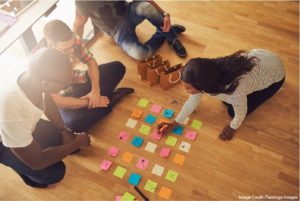I’ve been discussing a topic with colleagues in recent months, and want to share my thinking with you.
The outline for this blog post is:
An observation/question that has been nagging at me, then
A theory about the answer to the question, then
Possible implications of that theory.
Here goes:
A Puzzling Problem
In recent years, as I listen to discussions on BIG EDUCATIONAL TOPICS, I frequently find myself surprised by this truth:
Education is full of folks who are
- Obviously smart,
- Obviously well informed,
- Obviously concerned about their students, our profession, and our society, and
- FEROCIOUSLY, ANGRILY at odds with one another.
Seriously, if folks could punch one another online, Twitter would have LOTS of broken noses.
This observation leads to a straightforward question: why? Why do these ferocious disagreements persist?
If many of us think ably and know a lot and care deeply, it’s surprising that we disagree…and keep disagreeing. The heated arguments just don’t change much.
In many scientific fields, heated arguments result – over time, at least – in the ultimate persuasiveness of one case or another.
Plate tectonics used to be a controversial topic, with lots of heated rhetoric. Today, those debates among smart, knowledgeable, and caring people have resulted in something like consensus: the theory is almost certainly correct.
Surgeons now wash their hands before surgery. That practice was initially scorned, but now the anti-handwashing argument seems impossible to understand. OF COURSE one side prevailed in the debate.
Why haven’t educational debates followed this pattern? Why haven’t our disagreements led ultimately to agreements?
One Possibility
I’ve been discussing a possible answer with several friends: here goes.
I wonder if our debates remain so heated because we don’t agree on the GOALS of education. In fact, we aren’t even in the habit of discussing those goals – or the habit of connecting them to teaching practices.
Off the top of my head, I can imagine all sorts of big-picture goals for the millions of dollars and millions of hours our society devotes to creating and maintaining its educational system.
If I were to ask 100 people this question, I can imagine a wide range of answers: “the goal of our educational system is to…
- Create a workforce for the future,” or
- Help students understand and enact the word of God,” or
- Know the best that has been thought or said,” or
- Ensure that individual students develop to their fullest potential,” or
- Promote justice, equity, and peace,” or
- Preserve our culture and way of life,” or
- Raise scores on key benchmark assessments,” or
- Prepare children and society for an unpredictable future,” or
- Develop students who see themselves as readers, historians, scientists, etc.,” or
- Ensure that students know the curriculum,” or
- Create an informed and civic-minded electorate,” or
- Foster a love of learning so that students become life-long learners,” or …
…and so forth.
Perhaps the reason our debates about teaching strategies go nowhere is that we’re in fact trying to go different places.
That is:
I might read about a teaching strategy and think “Pish posh. That’s obviously bonkers. It simply won’t accomplish the core aims of education.”
And yet, the person proposing the strategy might well have entirely different aims. And – sure enough – the teaching strategy being proposed might achieve their core aims, if not mine.
If, for example, I practice the Awesome Watson Learning Method, I might to do because it fosters a love of learning (goal 12) and ensures that students see themselves as writers and programmers and doctors (goal 9).
A critic might respond: “that pedagogy won’t accomplish our goal!” And that criticism might be sincere, because the pedagogy doesn’t (let’s say) help students “learn the greatest that has been thought or said” (goal 3). Yet because I’m not striving for goal 3, I’m genuinely vexed and puzzled by my critic’s (obviously incorrect) critique.
Humbling Implications
If I’m right that our “debates” simply talk past one another because we don’t share — or discuss — educational goals, that realization suggests several next steps.
Step A:
The next time I hear someone espouse a teaching method that strikes me as foolish, I should switch from contempt to curiosity.
Rather than “pish posh,” I should say: “That’s intriguing — tell me more!”
If I ask the right questions in an open-minded, non-snarky way, I might discover an entirely unexpected goal at the end of the process. I might not agree about the importance of that goal, but I might …
…understand why the other person champions it, and
…recognize that the teaching strategy I once thought foolish might in fact accomplish it.
Sadly, this “switch from contempt to curiosity” is really difficult. I will face the constant temptation to ask leading questions and trap my interlocutors into admitting that my goal surpasses theirs in wisdom and beauty.
(The best book I’ve read that discusses this problem is David McRaney’s How Minds Change. It has really shaped my thinking on this challege.)
Step B:
Since 2008, I’ve been thinking about using scientific research — especially in psychology and neuroscience — to improve my teaching.
Obviously, this approach focuses on numerical measurements: calculations, graphs, statistics.
In other words: I believe that my teaching strategies accomplish my goals because I’ve got numbers that say so.
However, several of the big-picture goals listed above simply can’t be measured.
How would I know if the Awesome Watson Teaching Method…
… helps students become life-long learners?
… ultimately fosters civic engagement?
… encourages students to live and act according to God’s word?
The end point for these goals (and others) lies decades away — and will be influenced by THOUSANDS of other forces.
This fact, however, does not necessarily invalidate the potential importance of those goals.
Teachers might not be able to show a study — with p-values in the appropriate range, and a Cohen’s d above 0.2 — concluding that their teaching method promotes justice and peace. But that impossibility does not mean that their goal has no merit.
In other words: I’m attracted to a science-y approach to thinking about teaching practice, and I like being able to cite all those numbers. (92% of in-classroom studies show that retrieval practice promotes long-term memory better than control conditions!)
But science-y approaches can’t routinely dictate answers to moral or ethical questions.
Another Possibility?
Of course, I have a MUCH simpler explanation for the fact that many people disagree with me — often angrily:
Those other people could be daft, ignorant, and/or immoral.
That explanation has several benefits.
- It’s easy to summarize.
- It converts me from a person into a hero/protagonist.
- It frees me from the need to listen to their foolish, ill-informed, morally-tainted ideas.
At the same time, I find this simpler explanation unsatisfying — because I disagree with many people who don’t strike me as daft or wicked.
Perhaps there’s a third explanation?
TL;DR
I’m trying to focus less on why others are wrong. I’m trying to focus more on their implied goals for education — goals that have led them to teaching advice that puzzles or alarms me.
When I understand their goals, I might better understand — and learn from — their teaching suggestions.
Perhaps you’ll join me in this effort — and let me know what you learn.
In case the title of this post doesn’t make sense: researchers in the world of mindset encourage a less focus on performance goals (test scores, etc.) and more focus on learning goals (“look! I made progress!”).
This blog post isn’t about mindset-y learning goals, but about society’s broader goals for education.









